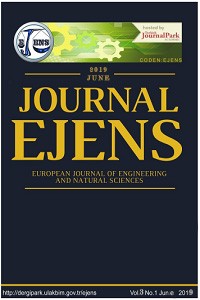Öz
This
study presents the results of chromate adsorption upon chitosan modified with
thiourea, glutaraldehyde. Firstly modified chitosan was synthesized by using thiourea, glutaraldehyde and
chitosan at different molar ratios and adsorption capacities were compared to
the original chitosan. The modified chitosan showed higher Cr (VI) retention
performance than the original chitosan. While the original chitosan had a
percent removal of 32% at an initial concentration of 50 ppm, the percentage of
chitosan removal improved to 99.9%. Kinetic and thermodynamic constants are
determined at appropriate ambient conditions and adsorption is defined by appropriate
adsorption isotherms. Langmuir isotherms were found to be suitable for
characterizing the adsorption of chitosan with the modified Cr (VI) ions. Under
appropriate experimental conditions, percentages of removal in Cr (VI) removal
studies by adsorption using modified chitosan reached 99% and adsorption
capacity of 442 mg/g was observed.Characterization of the modified chitosan and
original chitosan were characterized by FTIR (Fourier Transform Infrared
Spectroscopy), TGA (Thermal Gravimetric Analysis), XRD (X-ray Diffraction) and
DSC (Differential Scanning Calorimetry) .
Anahtar Kelimeler
Kaynakça
- [1]. Özdede, A., ‘‘Investigation of removal conditions of some heavy metals from aqueous solutions using polypyrrole / chitosan composite polymer.’’, Graduate thesis, Dumlupınar University Institute of Science, Kütahya, 2013.[2]. Acar, F. N.Malkoc, E. ‘‘The removal of chromium (vı) from aqueous solutions by fagus orientalis’’ Bioresource Technology, 94, 13-15, 2014. [3]. Kumar, P. A., Ray, M., Chakraborty, S. ‘‘Hexavalent chromium removal from wastewater using aniline formaldehyde condensate coated silica gel.’’ Journal of Hazardous Materials, 143, 24-32, 2007.[4]. Water Pollution Regulation Control Regulation, Official Gazette, Ankara, 1988.[5]. Babel, S., Kurniawan, T. A. ‘‘Low-cost adsorbents for heavy metals up-take from contaminated water: a review,’’ Journal of Hazardous Materials, 97, 219-243,2013.[6]. Crini, G., Badot, P. M. ‘‘Application of chitosan, a natural aminopoly-saccharide, for dye removal from aqueous solutions by adsorption processes using batch studies: a review of recent literature,’’ Progress in Polymer Science, 33, 399-447, 2008. [7]. Khan, T. A., Peh, K. K., Chng, H. S. ‘‘Reporting degree of deacetylation values of chitosan: the influence of analytical methods,’’ J. Pharm Pharmaceut Sci, 5, 205-212, 2002.[8]. He, C., Yang, Z., Ding, J., Chen, Y., Tong, X., Li, Y. ‘‘Effective removal of Cr(VI) from aqueous solution by 3-aminopropyltriethoxysilane- functionalized graphene oxide. colloids and surfaces a: physicochemical and Engineering Aspects’’, 520, 448-458, 2017.[9]. Erdoğan, Y. A.‘‘Arsenic removal from various wastewaters with various adsorbents’’, Ph.D. thesis, ITU Institute of Science and Technology, Istanbul, 2015.[10]. Guibal, E., Sweeney, N. V. O., Vincent, T., Tobin, J. M.‚‘‘Sulphur derivatives of chitosan for palladium sorption, Reactive and Functional Polymers’’ 50, 149-163,2002.[11]. Sıvri, N. ‘‘Hexavalent chromium removal from waste water in fixed bed examination’’. Master thesis, ITU Institute of Science and Technology, Istanbul.2015.[12]. Abdullah, M. A., Chiang, L., Nadeem, M. ‘‘Comparative evaluation of adsorption kinetics and isotherms of a natural product removal by amberlite polymeric adsorbents’’, Chemical Engineering Journal, 146, 370-376.2009.[13]. Monteiro, O. A., Airoldi, C. ‘‘Some studies of crosslinking chitosan–glutaraldehyde interaction in a homogeneous system,’’ International Journal of Biological Macromolecules, 26, 119-128.1999.[14]. Sankararamakrishnan, N., & Sanghi, R. ‘‘Preparation and characterization of a novel xanthated chitosan’’., Carbohydrate Polymers, 66, 160-167. 2006.[15]. Farmer, S., Selda, Ö. Z. E. K., Aksoy, S. A., Aksoy, K., & Fethiye, G. Ö. D. E., ‘‘Nanocrystalline PVA / chitosan nanofiber synthesis and characterization’’ SDU Science Magazine, 10.2015.[16]. Çulcu. L.‘‘Investigation of adsorption of cyanide blue 62 used in textile industry on crosslinked chitosan’, Master thesis, Institute of Science and Technology, Istanbul.2015.
Öz
Kaynakça
- [1]. Özdede, A., ‘‘Investigation of removal conditions of some heavy metals from aqueous solutions using polypyrrole / chitosan composite polymer.’’, Graduate thesis, Dumlupınar University Institute of Science, Kütahya, 2013.[2]. Acar, F. N.Malkoc, E. ‘‘The removal of chromium (vı) from aqueous solutions by fagus orientalis’’ Bioresource Technology, 94, 13-15, 2014. [3]. Kumar, P. A., Ray, M., Chakraborty, S. ‘‘Hexavalent chromium removal from wastewater using aniline formaldehyde condensate coated silica gel.’’ Journal of Hazardous Materials, 143, 24-32, 2007.[4]. Water Pollution Regulation Control Regulation, Official Gazette, Ankara, 1988.[5]. Babel, S., Kurniawan, T. A. ‘‘Low-cost adsorbents for heavy metals up-take from contaminated water: a review,’’ Journal of Hazardous Materials, 97, 219-243,2013.[6]. Crini, G., Badot, P. M. ‘‘Application of chitosan, a natural aminopoly-saccharide, for dye removal from aqueous solutions by adsorption processes using batch studies: a review of recent literature,’’ Progress in Polymer Science, 33, 399-447, 2008. [7]. Khan, T. A., Peh, K. K., Chng, H. S. ‘‘Reporting degree of deacetylation values of chitosan: the influence of analytical methods,’’ J. Pharm Pharmaceut Sci, 5, 205-212, 2002.[8]. He, C., Yang, Z., Ding, J., Chen, Y., Tong, X., Li, Y. ‘‘Effective removal of Cr(VI) from aqueous solution by 3-aminopropyltriethoxysilane- functionalized graphene oxide. colloids and surfaces a: physicochemical and Engineering Aspects’’, 520, 448-458, 2017.[9]. Erdoğan, Y. A.‘‘Arsenic removal from various wastewaters with various adsorbents’’, Ph.D. thesis, ITU Institute of Science and Technology, Istanbul, 2015.[10]. Guibal, E., Sweeney, N. V. O., Vincent, T., Tobin, J. M.‚‘‘Sulphur derivatives of chitosan for palladium sorption, Reactive and Functional Polymers’’ 50, 149-163,2002.[11]. Sıvri, N. ‘‘Hexavalent chromium removal from waste water in fixed bed examination’’. Master thesis, ITU Institute of Science and Technology, Istanbul.2015.[12]. Abdullah, M. A., Chiang, L., Nadeem, M. ‘‘Comparative evaluation of adsorption kinetics and isotherms of a natural product removal by amberlite polymeric adsorbents’’, Chemical Engineering Journal, 146, 370-376.2009.[13]. Monteiro, O. A., Airoldi, C. ‘‘Some studies of crosslinking chitosan–glutaraldehyde interaction in a homogeneous system,’’ International Journal of Biological Macromolecules, 26, 119-128.1999.[14]. Sankararamakrishnan, N., & Sanghi, R. ‘‘Preparation and characterization of a novel xanthated chitosan’’., Carbohydrate Polymers, 66, 160-167. 2006.[15]. Farmer, S., Selda, Ö. Z. E. K., Aksoy, S. A., Aksoy, K., & Fethiye, G. Ö. D. E., ‘‘Nanocrystalline PVA / chitosan nanofiber synthesis and characterization’’ SDU Science Magazine, 10.2015.[16]. Çulcu. L.‘‘Investigation of adsorption of cyanide blue 62 used in textile industry on crosslinked chitosan’, Master thesis, Institute of Science and Technology, Istanbul.2015.
Ayrıntılar
| Birincil Dil | İngilizce |
|---|---|
| Konular | Mühendislik |
| Bölüm | Makaleler |
| Yazarlar | |
| Yayımlanma Tarihi | 27 Haziran 2019 |
| Yayımlandığı Sayı | Yıl 2019 Cilt: 3 Sayı: 1 |

